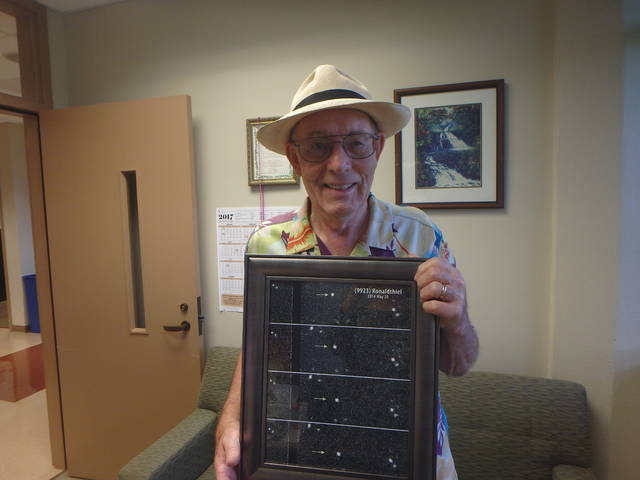Hawaii County Traffic Division Chief Ronald Thiel knows lights. Much of his work focuses on keeping local streets safe with street lights, traffic lights and hazard lights. ADVERTISING Hawaii County Traffic Division Chief Ronald Thiel knows lights. Much of his
Hawaii County Traffic Division Chief Ronald Thiel knows lights. Much of his work focuses on keeping local streets safe with street lights, traffic lights and hazard lights.
He also knows where lights are not helpful – when light pollution interferes with the work of astronomers and the lives of native wildlife.
For Thiel’s work preserving “dark skies” in Hawaii County, an asteroid was recently named in his honor – 9923 ronaldthiel.
The asteroid naming ceremony took place on Sept. 28, presented by Dr. Richard Wainscoat of the University of Hawaii at a meeting of the Mauna Kea User’s Committee in Hilo, a county news release stated. The asteroid was first discovered by astronomer Bobby Bus on March 7, 1981, with an orbit of 1,723 days around the sun. It has a diameter of 2.55 miles.
Over the years, Thiel has doggedly pushed for innovation, sometimes going against the flow of traffic. Industry naysayers said it could not be done with Light-Emitting-Diode (LED) lamps, so he waited for technology to catch up, and he searched for the right manufacturer.
In 2009, the American Recovery and Reinvestment Act made it possible to take small steps with the purchase of the first LED street lamps. Subsequent County investments and a partnership with the state of Hawaii resulted in the installation of 11,000 LED lamps on county and state roadways across Hawaii Island. Hawaii County, which is nearly the size of the state of Connecticut, became the first county in the nation to convert all of its street lights to LED lamps.
The LED lamps support the Island’s $58.4 million astronomy industry’s needs for dark skies. Island observatories scan the heavens to improve our understanding of the far reaches of space, including asteroids like the 9923 ronaldthiel.




